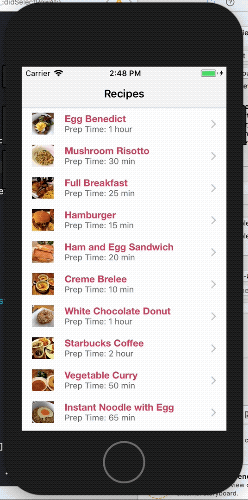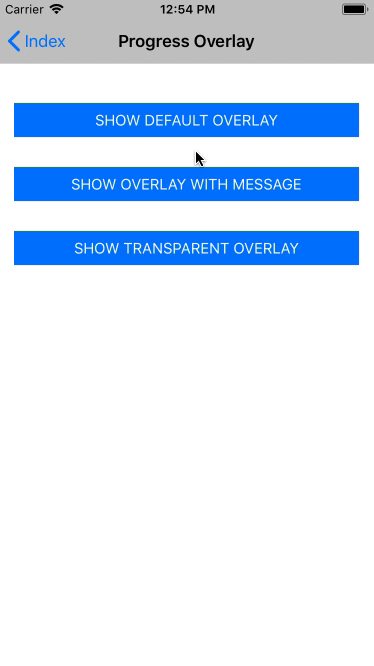iOS에서 긴 작업을 실행할 때 "오버레이" 로드
긴 작업을 수행할 때 Swift IOS 응용 프로그램에서 오버레이를 로드하는 예는 무엇입니까?원격 서버에서 데이터를 로드하는 예입니다.나는 구글에 검색했지만 답을 찾지 못했습니다.
업데이트됨:
@Sebastian Dressler에게 감사합니다. 이것은 간단한 방법입니다.코드를 업데이트했더니 정상적으로 실행됩니다.
public class LoadingOverlay{
var overlayView = UIView()
var activityIndicator = UIActivityIndicatorView()
class var shared: LoadingOverlay {
struct Static {
static let instance: LoadingOverlay = LoadingOverlay()
}
return Static.instance
}
public func showOverlay(view: UIView) {
overlayView.frame = CGRectMake(0, 0, 80, 80)
overlayView.center = view.center
overlayView.backgroundColor = UIColor(hex: 0x444444, alpha: 0.7)
overlayView.clipsToBounds = true
overlayView.layer.cornerRadius = 10
activityIndicator.frame = CGRectMake(0, 0, 40, 40)
activityIndicator.activityIndicatorViewStyle = .WhiteLarge
activityIndicator.center = CGPointMake(overlayView.bounds.width / 2, overlayView.bounds.height / 2)
overlayView.addSubview(activityIndicator)
view.addSubview(overlayView)
activityIndicator.startAnimating()
}
public func hideOverlayView() {
activityIndicator.stopAnimating()
overlayView.removeFromSuperview()
}
}
다음을 사용하여 허용:
LoadingOverlay.shared.showOverlay(self.view)
//To to long tasks
LoadingOverlay.shared.hideOverlayView()
위의 답변은 로드 보기를 추가하지만 화면의 클릭 이벤트를 차단하지 않으며 나머지 화면에 대한 오버레이도 제공하지 않습니다.다음과 같이 수행할 수 있습니다.
let alert = UIAlertController(title: nil, message: "Please wait...", preferredStyle: .Alert)
alert.view.tintColor = UIColor.blackColor()
let loadingIndicator: UIActivityIndicatorView = UIActivityIndicatorView(frame: CGRectMake(10, 5, 50, 50)) as UIActivityIndicatorView
loadingIndicator.hidesWhenStopped = true
loadingIndicator.activityIndicatorViewStyle = UIActivityIndicatorViewStyle.Gray
loadingIndicator.startAnimating();
alert.view.addSubview(loadingIndicator)
presentViewController(alert, animated: true, completion: nil)
스위프트 3.0
let alert = UIAlertController(title: nil, message: "Please wait...", preferredStyle: .alert)
let loadingIndicator = UIActivityIndicatorView(frame: CGRect(x: 10, y: 5, width: 50, height: 50))
loadingIndicator.hidesWhenStopped = true
loadingIndicator.activityIndicatorViewStyle = UIActivityIndicatorViewStyle.gray
loadingIndicator.startAnimating();
alert.view.addSubview(loadingIndicator)
present(alert, animated: true, completion: nil)
Swift 4.0 이상
let alert = UIAlertController(title: nil, message: "Please wait...", preferredStyle: .alert)
let loadingIndicator = UIActivityIndicatorView(frame: CGRect(x: 10, y: 5, width: 50, height: 50))
loadingIndicator.hidesWhenStopped = true
loadingIndicator.style = UIActivityIndicatorView.Style.gray
loadingIndicator.startAnimating();
alert.view.addSubview(loadingIndicator)
present(alert, animated: true, completion: nil)
다음과 같이 숨길 수 있습니다.
dismiss(animated: false, completion: nil)
다음과 같이 표시됩니다.
오버레이 보기를 직접 생성하여 상위 보기에 추가하고 작업이 완료되면 제거합니다. 예를 들어 다음과 같이 추가할 수 있습니다.
var overlay : UIView? // This should be a class variable
[ ... ]
overlay = UIView(frame: view.frame)
overlay!.backgroundColor = UIColor.blackColor()
overlay!.alpha = 0.8
view.addSubview(overlay!)
탈거용:
overlay?.removeFromSuperview()
배경 흐림 + 활동 표시기, Swift 5 예
extension UIView {
func showBlurLoader() {
let blurLoader = BlurLoader(frame: frame)
self.addSubview(blurLoader)
}
func removeBluerLoader() {
if let blurLoader = subviews.first(where: { $0 is BlurLoader }) {
blurLoader.removeFromSuperview()
}
}
}
class BlurLoader: UIView {
var blurEffectView: UIVisualEffectView?
override init(frame: CGRect) {
let blurEffect = UIBlurEffect(style: .dark)
let blurEffectView = UIVisualEffectView(effect: blurEffect)
blurEffectView.frame = frame
blurEffectView.autoresizingMask = [.flexibleWidth, .flexibleHeight]
self.blurEffectView = blurEffectView
super.init(frame: frame)
addSubview(blurEffectView)
addLoader()
}
required init?(coder aDecoder: NSCoder) {
fatalError("init(coder:) has not been implemented")
}
private func addLoader() {
guard let blurEffectView = blurEffectView else { return }
let activityIndicator = UIActivityIndicatorView(style: .whiteLarge)
activityIndicator.frame = CGRect(x: 0, y: 0, width: 50, height: 50)
blurEffectView.contentView.addSubview(activityIndicator)
activityIndicator.center = blurEffectView.contentView.center
activityIndicator.startAnimating()
}
}
저처럼 늦은 사람을 위해, 저는 @Sonrobby 코드를 약간 수정했습니다.내가 이해한 바로는, @Sonrobby는 매 시간마다 활동을 오버레이에 추가합니다.showOverlay그리고 일부 구성은 init 함수로 전달될 수 있으며, 오직 위치만이 가능합니다.showOverlay방법.
제 앱이 대부분 흰색이기 때문에 오버레이 배경도 검은색으로 변경합니다.
코드는 다음과 같습니다.
public class LoadingOverlay{
var overlayView : UIView!
var activityIndicator : UIActivityIndicatorView!
class var shared: LoadingOverlay {
struct Static {
static let instance: LoadingOverlay = LoadingOverlay()
}
return Static.instance
}
init(){
self.overlayView = UIView()
self.activityIndicator = UIActivityIndicatorView()
overlayView.frame = CGRectMake(0, 0, 80, 80)
overlayView.backgroundColor = UIColor(white: 0, alpha: 0.7)
overlayView.clipsToBounds = true
overlayView.layer.cornerRadius = 10
overlayView.layer.zPosition = 1
activityIndicator.frame = CGRectMake(0, 0, 40, 40)
activityIndicator.center = CGPointMake(overlayView.bounds.width / 2, overlayView.bounds.height / 2)
activityIndicator.activityIndicatorViewStyle = .WhiteLarge
overlayView.addSubview(activityIndicator)
}
public func showOverlay(view: UIView) {
overlayView.center = view.center
view.addSubview(overlayView)
activityIndicator.startAnimating()
}
public func hideOverlayView() {
activityIndicator.stopAnimating()
overlayView.removeFromSuperview()
}
}
@Ajinkya Patil은 참조로 대답합니다.Swift 4.0 이상
이것은 충돌 없이 모든 뷰 컨트롤러에서 사용할 수 있는 확장 솔루션입니다.
로드 대화상자 만들기+보기컨트롤러.swift
import UIKit
struct ProgressDialog {
static var alert = UIAlertController()
static var progressView = UIProgressView()
static var progressPoint : Float = 0{
didSet{
if(progressPoint == 1){
ProgressDialog.alert.dismiss(animated: true, completion: nil)
}
}
}
}
extension UIViewController{
func LoadingStart(){
ProgressDialog.alert = UIAlertController(title: nil, message: "Please wait...", preferredStyle: .alert)
let loadingIndicator = UIActivityIndicatorView(frame: CGRect(x: 10, y: 5, width: 50, height: 50))
loadingIndicator.hidesWhenStopped = true
loadingIndicator.style = UIActivityIndicatorView.Style.gray
loadingIndicator.startAnimating();
ProgressDialog.alert.view.addSubview(loadingIndicator)
present(ProgressDialog.alert, animated: true, completion: nil)
}
func LoadingStop(){
ProgressDialog.alert.dismiss(animated: true, completion: nil)
}
}
ViewController 내부의 기능을 원하는 곳으로 호출합니다.이와 같이:
self.LoadingStart()
로드 대화 상자를 중지하는 방법은 다음과 같습니다.
self.LoadingStop()
추가로 코드를 실행하려고 할 때 문제가 발생할 수 있습니다.개인적으로 showOverlay가 제대로 호출되지 않는 경우가 있었습니다(장면에 segue를 설정하고 viewDidLoad 중에 이 함수를 즉시 호출하려고 했기 때문입니다).
저와 유사한 문제가 발생할 경우 코드에 대한 한 가지 수정 사항과 접근 방식의 변경을 권장합니다.
픽스: 다음과 같이 dispatch_async 호출에 대한 두 코드 블록을 폐쇄로 배치합니다.
dispatch_async(dispatch_get_main_queue(),
{ //code });
접근: 코드를 호출할 때 메인 대기열에 dispatch_after 호출을 수행하여 호출을 몇 밀리초 지연시킵니다.
이유는?당신은 단순히 viewDidLoad 동안 UI에 너무 많은 것을 요청하는 것입니다.
해결책에 대한 이 부록이 도움이 된다면 기쁘겠습니다.
-조엘 롱
P.S. 솔루션은 XCode v6.3.2에서 작동했습니다.
ATKit를 사용합니다.
참조: https://aurvan.github.io/atkit-ios-release/index.html
ATP 진행률 오버레이 클래스 https://aurvan.github.io/atkit-ios-release/helpbook/Classes/ATProgressOverlay.html
코드:
import ATKit
ATProgressOverlay.sharedInstance.show() // Does not show network activity indicator on status bar.
ATProgressOverlay.sharedInstance.show(isNetworkActivity: true) // Shows network activity indicator on status bar.
스크린샷:
스위프트 5
class func showUniversalLoadingView(_ show: Bool, loadingText : String = "") {
let existingView = UIApplication.shared.windows[0].viewWithTag(1200)
if show {
if existingView != nil {
return
}
let loadingView = self.makeLoadingView(withFrame: UIScreen.main.bounds, loadingText: loadingText)
loadingView?.tag = 1200
UIApplication.shared.windows[0].addSubview(loadingView!)
} else {
existingView?.removeFromSuperview()
}
}
class func makeLoadingView(withFrame frame: CGRect, loadingText text: String?) -> UIView? {
let loadingView = UIView(frame: frame)
loadingView.backgroundColor = UIColor(red: 0, green: 0, blue: 0, alpha: 0.5)
let activityIndicator = UIActivityIndicatorView(frame: CGRect(x: 0, y: 0, width: 100, height: 100))
//activityIndicator.backgroundColor = UIColor(red:0.16, green:0.17, blue:0.21, alpha:1)
activityIndicator.layer.cornerRadius = 6
activityIndicator.center = loadingView.center
activityIndicator.hidesWhenStopped = true
activityIndicator.style = .white
activityIndicator.startAnimating()
activityIndicator.tag = 100 // 100 for example
loadingView.addSubview(activityIndicator)
if !text!.isEmpty {
let lbl = UILabel(frame: CGRect(x: 0, y: 0, width: 200, height: 30))
let cpoint = CGPoint(x: activityIndicator.frame.origin.x + activityIndicator.frame.size.width / 2, y: activityIndicator.frame.origin.y + 80)
lbl.center = cpoint
lbl.textColor = UIColor.white
lbl.textAlignment = .center
lbl.text = text
lbl.tag = 1234
loadingView.addSubview(lbl)
}
return loadingView
}
사용하다
showUniversalLoadingView(true, loadingText: "Downloading Data.......")
범용 로딩 뷰 표시(참)
로더 제거
showUniversalLoadingView(false)
@sonrobby 응답 업데이트, 마스크 크기 조정을 통한 배경 보기 및 방향 처리 추가...이것은 간단한 것들에 사용될 수 있습니다.
public class LoadingOverlay{
var overlayView = UIView()
var activityIndicator = UIActivityIndicatorView()
var bgView = UIView()
class var shared: LoadingOverlay {
struct Static {
static let instance: LoadingOverlay = LoadingOverlay()
}
return Static.instance
}
public func showOverlay(view: UIView) {
bgView.frame = view.frame
bgView.backgroundColor = UIColor.gray
bgView.addSubview(overlayView)
bgView.autoresizingMask = [.flexibleLeftMargin,.flexibleTopMargin,.flexibleRightMargin,.flexibleBottomMargin,.flexibleHeight, .flexibleWidth]
overlayView.frame = CGRect(x: 0, y: 0, width: 80, height: 80)
overlayView.center = view.center
overlayView.autoresizingMask = [.flexibleLeftMargin,.flexibleTopMargin,.flexibleRightMargin,.flexibleBottomMargin]
overlayView.backgroundColor = UIColor.black
overlayView.clipsToBounds = true
overlayView.layer.cornerRadius = 10
activityIndicator.frame = CGRect(x: 0, y: 0, width: 40, height: 40)
activityIndicator.activityIndicatorViewStyle = .whiteLarge
activityIndicator.center = CGPoint(x: overlayView.bounds.width / 2, y: overlayView.bounds.height / 2)
overlayView.addSubview(activityIndicator)
view.addSubview(bgView)
self.activityIndicator.startAnimating()
}
public func hideOverlayView() {
activityIndicator.stopAnimating()
bgView.removeFromSuperview()
}
}
키 창에 추가하면 탐색 및 탭 표시줄에도 추가할 수 있습니다.이와 같은 것
LoadingOverlay.shared.showOverlay(view: UIApplication.shared.keyWindow!)
스위프트 3.
아래 답변에 @Lucho의 코드를 사용하였고 오버레이 배경색을 클리어로 변경하여 스피너 색상을 추가하였습니다.
public class LoadingOverlay {
var overlayView : UIView!
var activityIndicator : UIActivityIndicatorView!
class var shared: LoadingOverlay {
struct Static {
static let instance: LoadingOverlay = LoadingOverlay()
}
return Static.instance
}
init(){
self.overlayView = UIView()
self.activityIndicator = UIActivityIndicatorView()
overlayView.frame = CGRect(0, 0, 80, 80)
overlayView.backgroundColor = .clear
overlayView.clipsToBounds = true
overlayView.layer.cornerRadius = 10
overlayView.layer.zPosition = 1
activityIndicator.frame = CGRect(0, 0, 40, 40)
activityIndicator.center = CGPoint(overlayView.bounds.width / 2, overlayView.bounds.height / 2)
activityIndicator.activityIndicatorViewStyle = .whiteLarge
activityIndicator.color = .gray
overlayView.addSubview(activityIndicator)
}
public func showOverlay(view: UIView) {
overlayView.center = view.center
view.addSubview(overlayView)
activityIndicator.startAnimating()
}
public func hideOverlayView() {
activityIndicator.stopAnimating()
overlayView.removeFromSuperview()
}
}
자신의 뷰 컨트롤러를 오버레이로 표시하기 위한 프로토콜을 만들었습니다.사용법은 매우 간단합니다.
class ViewController: UIViewController, OverlayHost {
@IBAction func showOverlayButtonPressed() {
showOverlay(type: YourOverlayViewController.self,
fromStoryboardWithName: "Main")
}
}
결과:
소스 코드: https://github.com/agordeev/OverlayViewController
관련 기사: https://andreygordeev.com/2017/04/18/overlay-view-controller-protocols-swift/
사마린.iOS 버전:
var alert = UIAlertController.Create(string.Empty, "Please wait...", UIAlertControllerStyle.Alert);
var alertIndicatorView = new UIActivityIndicatorView();
alertIndicatorView.Frame = new CGRect(x: 10, y: 5, width: 50, height: 50);
alertIndicatorView.ActivityIndicatorViewStyle = UIActivityIndicatorViewStyle.Gray;
alertIndicatorView.HidesWhenStopped = true;
alertIndicatorView.StartAnimating();
alert.Add(alertIndicatorView);
controller.PresentViewController(alert, true, null);
로드 뷰를 위해 Lottie 구현을 찾는 사용자가 있다면 @Shourob Data 솔루션을 사용하여 만든 작업 솔루션은 다음과 같습니다.
import Foundation
import UIKit
import Lottie
public class LogoLoadingAnimation{
class func showUniversalLoadingView(_ show: Bool, loadingText : String = "") {
let existingView = UIApplication.shared.windows[0].viewWithTag(1200)
if show {
if existingView != nil {
return
}
let loadingView = self.makeLoadingView(withFrame: UIScreen.main.bounds, loadingText: loadingText)
loadingView?.tag = 1200
UIApplication.shared.windows[0].addSubview(loadingView!)
} else {
existingView?.removeFromSuperview()
}
}
class func makeLoadingView(withFrame frame: CGRect, loadingText text: String?) -> UIView? {
let gradienView = GradientBackgroundView(frame: frame)
gradienView.startColor = UIColor(red: 255, green: 255, blue: 255, alpha: 1)
gradienView.endColor = UIColor(red: 238, green: 238, blue: 238, alpha: 1)
gradienView.startColor = UIColor(named: "dark") ?? .blue
gradienView.startColor = UIColor(named: "purpuleGrey") ?? .gray
let loadingAnimationView = AnimationView()
gradienView.addSubview(loadingAnimationView)
loadingAnimationView.translatesAutoresizingMaskIntoConstraints = false
loadingAnimationView.centerXAnchor.constraint(equalTo: gradienView.centerXAnchor).isActive = true
loadingAnimationView.centerYAnchor.constraint(equalTo: gradienView.centerYAnchor).isActive = true
loadingAnimationView.animation = UITraitCollection.current.userInterfaceStyle == .dark ? Animation.named("logoLoadingWhite") : Animation.named("logoLoadingBlue")
loadingAnimationView.backgroundBehavior = .pauseAndRestore
loadingAnimationView.contentMode = .scaleAspectFit
loadingAnimationView.loopMode = .loop
loadingAnimationView.play()
return gradienView
}
}
언급URL : https://stackoverflow.com/questions/27960556/loading-an-overlay-when-running-long-tasks-in-ios
'code' 카테고리의 다른 글
| 상위 구성 요소의 속성 액세스 (0) | 2023.09.10 |
|---|---|
| 안드로이드 및 (이미지) 보기 알파에 대한 알파 (0) | 2023.09.10 |
| C에서 메모리를 어떻게 해제합니까? (0) | 2023.09.05 |
| jQuery $.ajax(), 성공 데이터를 별도의 함수로 전달 (0) | 2023.09.05 |
| ER_PARSE_ERROR: SQL 구문에 오류가 있습니다. 사용할 올바른 구문은 MariaDB 서버 버전에 해당하는 설명서에서 확인하십시오. (0) | 2023.09.05 |



